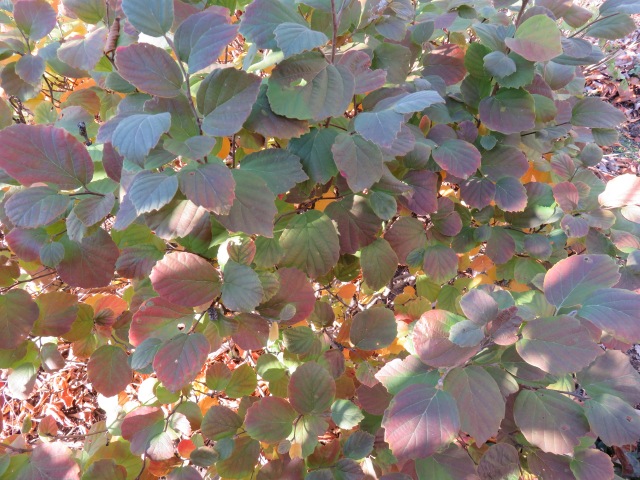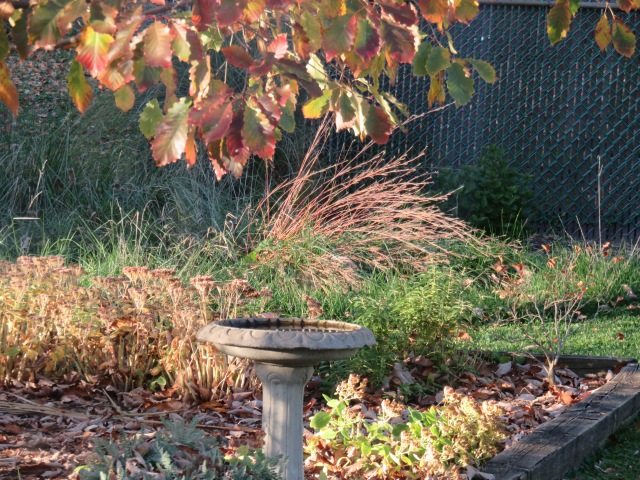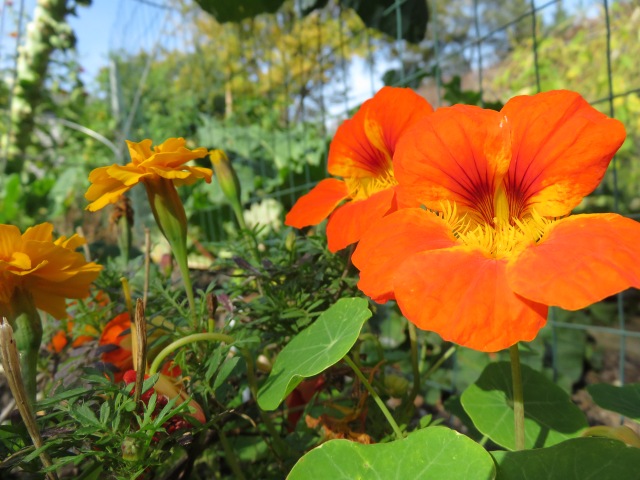It has been fun watching the fall colors peak in the yard this past week. We had our first frost last night on November 11th. I don’t remember such a long growing season before, and the frost may not have been a killing frost for the tomatoes and peppers.

Carpinus caroliniana, with common names American hornbeam, blue beech or musclewood. The top leaves turned pink/orange a few weeks ago and fell off earlier. This picture was taken on November 8th. The other American hornbeam we bought from Possibility Place Nursery turns yellow in the fall, so maybe they are variations of some type.

American hornbeam fall color.

Dwarf fothergilla bush, possible ‘beaver creek.’ I replanted this bush at this location in the spring and hope it will settle in to its new location this coming year. This bush started turning color weeks ago.

On November 6th the other fothergilla bush was still green, with the second American hornbeam, on the left, and the spice bush, on the right, very yellow.

By November 8th the yellow leaves had mostly fallen and the chinquapin oak leaves on the right were turning color as well.

Today, November 12th, the fothergilla leaves are just starting to turn. They should turn brilliant colors over the next week. I enjoy watching these changes out my office window.

Quercus muehlenbergii, chinquapin oak tree, starting to turn color on November 3rd. I put these date up so that I can compare year by year as the weather gradually warms.

Here is a close up of the chinquapin oak leaves on November 10th. Today we mulched up a lot of them when we mowed the lawn and started the fall compost leaf pile.

The American plum trees are nothing special in the fall, though stunning when they blossom in spring.

The neighbor’s maple tree is always beautiful in the fall.

MIscanthus ‘morning light.’ The was a great growing season and this miscanthus ornamental grass is well over 6 feet this year. The seed heads on our zebra grass seemed to be 8 or 9 feet high.

Out the kitchen window I caught a glimpse of the little blue stem grass that has turned red in the fall.

When I finished working in the garden today a few dark-eyed juncos got to work poking around on the ground. They are winter residents. The garlic plants I did not harvest earlier have grown back in bright green shoots.

On Wednesday morning I did a little birding and managed to capture this sparrow in a picture. I am not sure if it is an American tree sparrow or another kind of sparrow.

I think this is a pied-billed grebe, though the bill does not look quite right. Anyway, I love the fluffy feathers and the reflection! This was at Lake Katherine on a morning walk.

The nasturtiums and marigolds have been so beautiful in the yard this year.

I have had a fresh pepper for my lunch salad every day and there are still quite a few left to eat, so I feel blessed.

Beans soaking for tomorrow’s soup. These were from the pole beans that I left to dry on the vine. After we had a ton of green beans in the fridge, and the mosquitoes were killing me, I stopped picking the rest of the beans. This past week I finally pulled down the pole bean structure and shelled a lot of beans.

I am really enjoying reading this fascinating history book about Alexander Von Humboldt and his exploration of nature.
Hope you enjoy these weeks and it won’t be long before the snow flies!

Lovely fall colours! It’s been a long growing season here in Victoria, BC too. We haven’t had even a hint of frost yet. And we have juncos here too in the winter.
We just had another frost this morning. I can’t remember why I did not bring in the rest of the tomatoes and peppers yesterday…. I would think the frost in Victoria would be a little later than in Chicago, but not sure. I think we often have a frost in mid-October.
Our first frosts are usually in October too, often followed by warmer (wet) weather. This fall has been quite warm here, without any hint of crispness.
Beautiful colors you are getting. I read the Humboldt book back in September when we were camping and really enjoyed it. It inspired me to add several more books to my reading list.
Yes. Humboldt is inspiring. And I never really heard of him before! I am not finished yet, but I may want to read some more of the connected reading as well.
Miscanthus morning light is a grass I’ve seen before, but I never really knew its name. There’s nothing like Fall colors and grasses, and backyard in which to enjoy them. Good to meet you and read your blog!
Thanks for visiting! The grasshoppers and the praying mantis like to hide out in the miscanthus. I cut the stalks down in the spring and use them as a kind of mulch in the strawberries or elsewhere, though I have thrown out the seed heads, just in case they spread the grass where I don’t want it.
A good tip!
I wonder if one is Carpinus and the other Ostrya? It’s my understanding Ostrya turns yellow in Fall where Carpinus does the oranges/reds.
Wow! You might be right. I will need to investigate a little more. When we bought them they were dormant at the native plant nursery, so the seeds could have gotten mixed up, since the plants look so similar.